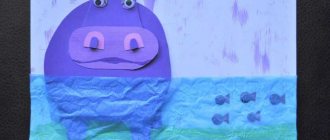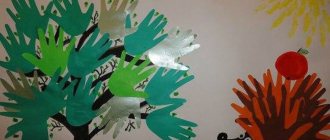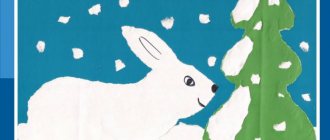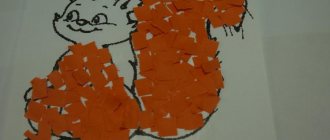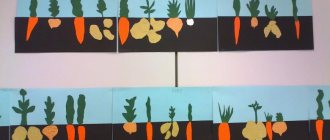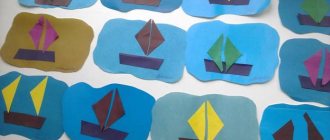Application is an excellent activity designed to comprehensively develop a child. Break applique is a separate direction. All age groups can use this technique, but it is most useful and interesting for children of primary preschool age. At this age, the development of fine motor skills is important for the development of a child, which this activity does an excellent job of. Let's look at examples and operating principles.
Lesson technology cut applique
Teacher: Guys, today we will look at interesting works and try to repeat them. Shows ready-made cut-out appliqués. Teacher: Do you know what such work is called? That's right, applique. This word is translated from Latin as “attachment.” This type of art has been known since ancient times; appliqués were made from pieces of leather, paper and fabric, which were glued to a base. The applique was used to decorate clothing, household items and home interiors. Take a close look at the pictures. What material is the applique made of? What gives it such edges? Yes, you can use your hands instead of scissors. Teacher: Let's also learn how to make cut-out appliqué. Let's make a birch tree. To do this you need:
- choose a background,
- glue a birch trunk to it,
- draw branches with a pencil,
- prepare leaves from colored paper by tearing them off,
- glue the leaves to the tree.
Torn paper may end up smooth or with fluffy edges. Try tearing the paper in different ways - lengthwise and crosswise, you will notice a certain pattern. Teacher: I suggest you get ready for work.
Teacher: Let’s quickly repeat the safety precautions together. Teacher: Now it remains to check whether all the material for work is available.
Children's independent work on making cut-out appliqué. Teacher: Your works turned out to be wonderful, I hung them in the office. Now continue the sentence:
- Today's lesson was interesting for me...
- I learned...
- I wanted …
- I found out that …
Cleaning workplaces. The trash is thrown into the bin, the glue is closed, and the remaining paper is folded into a pile. Teacher: Guys, you did a good job today. Thank you, you are great!
Technology lesson notes (2nd grade). Topic: Broken applique “Birch tree”
Topic: Broken applique “Birch tree”
Target:
1) creating conditions in the lesson for organizing students’ activities to acquire knowledge “break-through application”;
2) make a torn appliqué “Birch Tree” Objectives: 1. Subject:
• To introduce students to a new technique of working with paper: “tearing”;
perform work using the cutting appliqué technique • Develop fine motor skills of the hands; • Develop the ability to work in a team and respect for nature. • Encourage students to make gifts with their own hands and present them not only on significant dates, but also simply to express their good feelings • Foster accuracy and hard work 2. Meta-subject Cognitive UUD
• Analyze and read graphic images (drawings, simple drawings and sketches , diagrams) and carry out work according to them • Plan a sequence of practical actions to implement the plan, the assigned task
Regulatory UUD
• Organization of the workplace, rational placement of materials and tools at the workplace • Setting an educational task • Rational use and consumption of materials.
Communicative learning skills
• Be able to listen and engage in dialogue, participate in collective discussion • Productively interact and collaborate with peers
Personal learning skills
• Compliance with safe work practices • Exercise self-monitoring and adjustment of the progress of work and the final result • Form careful use and economical use of materials • Form interest in work
Teacher equipment:
finished product, presentation, samples of various types of applications.
Student equipment:
pencil, glue, colored paper, cardboard, eraser.
Lesson progress 1. Organizational moment.
Teacher. Hello guys! Sit down. Let's start the lesson. Let's check if you have everything ready for the lesson. You should have on your tables: glue, colored paper, cardboard, eraser.
Well done! Everyone is ready, let's get to work. Children check if they have everything on their desks (Colored paper, pencil, glue, cardboard.) 2. Setting goals and objectives for the lesson.
Teacher
.
Look at the work you see on your desks and on your screen. What technique was used to perform this work? Presentation slide No. 1
: various types of applications are projected onto the screen.
Student.
These works were made using the “applique” technique. Guys, how many of you know what applique is?
Appliqué translated from Latin means “attachment”. This is a very ancient form of art, an interesting type of artistic activity, when figures are cut out of pieces of leather, fabric or paper and then glued onto a base, that is, a background. In this case, the base can be cardboard, wood or thick paper. Applique belongs to decorative and applied arts. Guess the riddle: Green, not a meadow, White, not snow, Curly, but without hair. (Birch) Teacher. Children, look at the screen and at my work, what technique are these birch trees made in? Slide No. 2 of the presentation:
two images of a birch tree are projected onto the screen, made using the technique of “Break applique” and “Cut applique”
Student.
Using the “application” technique
Teacher
.
Did you notice anything interesting? Student.
Yes, they noticed.
In the first work the edges of the parts are not very uneven, but in the second the edges of the parts are even. Teacher.
You already know that with the help of scissors you can cut out various objects, shapes, figures, flowers and make patterns with them.
What do you guys think, is it possible to do without scissors? It turns out you can use your hands instead of scissors. What do you think this type of application can be called? Student
.
Torn, broken. Teacher. That's right, today in the lesson we will get acquainted with an interesting and unusual type of applique: “Break applique” How are such applications made? Student.
You don’t need to cut the paper, but rather tear it off to get this applique.
Teacher.
How to get jagged edges?
Student
.
Such edges can be obtained if you tear off the edges of the part, and not cut them out with scissors, that is, we will tear out all the details of the applique from a sheet of paper, and not cut them out with scissors. Teacher
.
What do such uneven edges give to the applique? Student.
The edges turn out fluffier, and the work seems voluminous.
3. Drawing up a work plan. Analysis. Teacher.
Review the sample.
Teacher.
What material is the product made of?
Student.
From paper.
Teacher
.
What tools will we need when working? Student
.
When working we will need: cardboard, colored paper, glue, pencil. Teacher
.
What parts does the work consist of? Student
.
From the trunk and leaves Teacher.
Let's practice tearing paper.
To begin, take a small piece of colored paper and try to tear it in different directions (lengthwise and crosswise). If you tear the paper along the grain, the edge will be smoother; if you tear it across, it will be more “spontaneous”, with a white halo. Now let's try to draw up a work plan. Guys, what kind of work plan will we draw up? What will we do first and so on. (Children's answers). Next, the teacher helps to draw up a unified work plan with the children. Work plan:
1. First, we need to choose a suitable background (blue cardboard).
2. Then we draw a birch trunk on white paper, approximately 4 cm wide. 3. After this, we cut off the trunk along the contour lines. 4. Next, draw black longitudinal and transverse stripes on the white side of the black paper. 5.After that, draw leaves on the white side of the green paper and tear off the excess paper along the contour. 6. Then we lay out the applique on the base. 7. Then glue all the parts onto the background and draw branches and buds with a black marker. Slide No. 3 of the presentation:
a work plan is projected onto the screen.
Work plan for making mushrooms: 1. Draw 5 brown ovals, and each subsequent oval should be smaller than the previous one. The first oval is the largest and yellow. 2.Tear off excess paper along the outline. 3.Take the yellow oval as a basis and gradually stick it on it, shifting the remaining ovals to the left or right in descending order. The product is made according to the sample. 4. Physical education minute.
To the words of the chant “Khomka”
5. Practical work of students
Students, with the help of the teacher, begin to do the work.
6. Analysis and exhibition of works. Teacher.
What great work you have done! A whole birch grove. Let's create an exhibition of our works and take pictures around it. I looked at your work and I think that you tried hard today and can use your work as a gift. I am sure that no matter who you present your work to, this person will definitely be happy, since your work was done with your own hands. And the best gift is a gift made with your own hands.
7. Summing up.
Teacher.
Guys, what was the topic of our lesson? What new did you learn? What have you learned? (Teacher's assessment of the work of the entire class.) 8. Cleaning workplaces.
Teacher. The lesson is over. We are cleaning all our work areas.
Lesson notes, broken applique
- The introductory part is to demonstrate the finished applications and ask the children if they know what technique the work was done in. Tell the children about the applique and the material for it.
- Studying new material - types and techniques of application.
- Preparation for work - physical training, preparation of the workplace. Check with the children whether they have the necessary material to complete the work using the cut appliqué technique. Tell children about safety rules while working.
- Completion of work by students.
- Results – an exhibition of works and comments for each work.
- Cleaning after application.
- Conclusion - ask the children what new they learned in today’s lesson, what they learned. Thank the children for their efforts.
Principle of operation
Paper crafts using the cut appliqué technique are made in 2 main ways.
Simple option
This option is suitable for the youngest children.
The stages of such creativity are as follows:
| № | Stage | Description |
| 1 | Preparing the template | At the initial stage, an adult (parent or teacher) must select a drawing suitable for the work - an outline on the basis of which the craft will be made. In this case, you can take a ready-made drawing or draw it yourself. When there is a background, all that remains is to put a picture on it. Its elements are torn off from colored paper and then glued to the main canvas. It is important to keep in mind that a large number of parts will be glued to the top of the canvas. |
| 2 | Selecting Colored Paper | The paper that serves as the background for this craft must be thick enough, so when choosing, you should pay attention not only to the color of the base, but also to the thickness. Children can be involved in the work. Along with them, you can choose the color of the paper that will be used for filling. After this, the child himself begins to tear off pieces of any size. |
| 3 | Gluing paper to background | It is necessary to take each piece of paper, apply an adhesive substance to one of its surfaces, and then apply it to the base one by one. It is most convenient to use a glue stick, because with its help you can evenly distribute the adhesive over the surface. When the space is filled, the work is completed. The result is a monochrome product, much like a mosaic. |
The option is more complicated
Cut-out paper applique (templates for products can be classic or abstract) always starts with an idea. After choosing a suitable example, the child begins to do everything independently, but at the same time, an adult must supervise his creative process in order to prevent mistakes.
Tear paper applique on a fairy tale theme
The stages of the complex version are as follows:
- Take thick colored paper. It can be any color.
- Attach a stencil to thick colored paper and trace it. If desired, you can apply a design to the surface of the paper without using a stencil.
- Select thin paper of the desired color and start tearing pieces from it.
- Fill the space with torn paper pieces. To do this, an adhesive is applied to each fragment; it is best to use a glue stick.
- After filling the entire space, the work is considered completed.
Templates for cut appliqué
First class cut-out applique, details with photo
Mushroom Material:
Progress:
- Cut two ovals from colored paper. One will be the stem of the mushroom, the other will be the cap.
- Trace ovals on paper with a pencil.
- Tear off any excess paper around the ovals.
- Tear each oval into small pieces.
- Lubricate the paper with a glue stick and glue the base of the mushroom. Do the same with the hat.
Broken applique second class, details with photo
Ladybug Material:
Progress:
- Print out the ladybug template on white paper.
- Fill the body with red using finely torn paper of the appropriate color and glue.
- Using black paper using the tearing technique, glue the spots onto the back and make a muzzle.
- Glue on the eyes from white paper.
Using napkins for applique
If you tear a napkin into small pieces and stick it on, you will create a volume effect and the craft will turn out airy.
If you are doing a craft with the image of trees, the trunks are cut out or drawn, and the leaves will be light, made from napkins. Pieces of napkins can also be rolled into balls.
Broken applique third grade, details with photo
Bullfinch Material:
Progress:
- Draw a silhouette of a bullfinch with a pencil.
- Using the cutting technique, prepare red pieces of paper.
- Glue these pieces immediately around the breast, and then fill everything inside.
- Prepare black scraps of paper.
- Glue them over the outline of the silhouette of the bullfinch, then continue gluing inside.
- Glue paper eyes onto the bird.
- Draw or cut out a branch from paper on which the bullfinch will sit and glue it.
Bunny made of paper
To create such a craft, pre-prepared templates with images of animals are perfect. In the photo of the broken appliqué you can see a bunny; thanks to the use of this technique, an interesting texture is created, the character looks more voluminous.
To create beautiful crafts, you can take templates by cutting them out of magazines, old coloring books, or print them from the Internet. You can also draw the figure yourself on paper or cardboard.
Crafts technique:
- Tear off the paper strips and then finely tear them into pieces.
- Glue these elements like a mosaic onto a pre-printed or drawn image.
- Try to make small distances between the pieces so that they do not overlap each other.
- The nose and eyes can also be torn from dark-colored paper or drawn on.
- Makes a great craft!
Broken applique fourth grade, details with photo
Winter Material:
Progress:
- Using the cutting technique, make a tree trunk. Glue to the background. When choosing a background, avoid white.
- Paint the house with paints.
- Finely tear the white paper - it will appear as snow.
- Using glue and small white pieces, cover the trees, house, and street with “snow.” You can glue small pieces throughout the picture, creating the appearance of snow falling on the city.
Cut-out birch applique, step by step with photo
Material:
Progress:
- Tear out a birch trunk from white paper and glue it to the background.
- Using the same technique, make branches and attach them to the paper with glue.
- Tear small black strips of paper and glue them to the trunk.
- Tear a lot of identical small leaves from green paper.
- Lubricate the places for the leaves with glue and glue the leaves to the paper.
Hedgehog applique, step by step with photo
Material:
Progress:
- Draw a hedgehog figure on the background sheet.
- Finely tear the paper for the muzzle and body.
- Lubricate the face with glue and attach the brown scraps.
- Glue black pieces of paper to the body.
Landscape made of paper
In order to create an entire landscape using the cut-out appliqué technique, you will need several sheets of colored paper, as well as pencil glue and a sheet of cardboard as a base.
- Now the most fun part of the job is tearing and crumpling colored paper.
- If you use crumpled paper to create a composition, it will look even more interesting and voluminous.
- Now you can collect parts for a future application.
- Develop your child's imagination by asking him what a piece of paper looks like.
- This way you can find creative and unexpected solutions.
- In addition, for children this is a real game, so the creative process will become even more interesting. If you have already outlined the elements of the picture on a sheet of paper, you can safely glue the details to the base.
- Attach the corners first so you can experiment by moving the paper pieces around.
When the picture is ready, carefully glue all the parts and let them dry thoroughly. The picture is ready, you can decorate it if you want and put it in a frame.
Sunflower cut-out applique, step by step with photo
Material:
Progress:
- Using a simple pencil, draw a sunflower on a white sheet of paper.
- Using the tearing technique, finely tear black paper and glue it into the core of the sunflower.
- Make a sunflower hat using small yellow pieces and glue.
- After tearing green paper, cover the trunk and leaves of the plant.
“Fox” applique made using the cutting technique
You will need:
- White base
- Chanterelle pattern
- Paper in three colors: orange, black and white
- Glue
Execution stages. Trace the stencil or draw the fox yourself on a white base.
Take orange paper and tear it into random pieces. Applying glue to each piece, we gradually fill the outline of the fox entirely. If the craft is being done by small children, it is better to cover the entire chanterelle - the base - with glue and stick the dry pieces from bottom to top.
Tear off two small, approximately identical pieces of black paper—the eyes—and glue them onto the fox. Another part will be needed for the spout. Tear off a small piece from a white sheet and make the tip of the fox's tail. Our fox is ready.
You can also not prepare pieces of paper in advance, but tear them off from the strip at the gluing site. Watch the video to see how this is done.
Cut-out applique vegetables, step by step with photo
Material:
Progress:
- Draw the outlines of vegetables on white paper and cut them out.
- Glue vegetables to the background.
- Tear many small pieces of the appropriate color for the vegetable.
- Apply glue to the vegetable template and glue on all the small scraps.
Cut-out applique pond with baby frogs, step by step with photo
Material:
- Colored paper
- PVA glue
- Pencil
Progress:
- Prepare small rectangles that will make up the parts of the frog’s body.
- In the background, mark the silhouettes of frogs with a simple pencil.
- Finely tear the green paper and glue the leaves to the silhouette.
- Make eyes and mouth from pieces of a different color.
- Using the cutting technique, prepare a lot of small blue pieces of paper.
- Apply glue to the area under the pond and glue blue pieces of paper.
Decoration of the composition
When the painting is ready, you can decorate it using all kinds of materials to give it a finished look and make the work unique.
- A few shells, dried flowers and leaves, ribbons, bows, buttons, beads, beads, rhinestones are perfect for this (adults should supervise the children’s work, especially if small parts are used in the process of creating a masterpiece).
- The resulting creation can be inserted into a beautiful frame. And then the child can safely participate in competitions with his works.
All these ideas will help you and your children create real masterpieces using a minimum of materials. And most importantly, this is a very fun and interesting process that can become leisure time for the whole family.
The finished work can become a wonderful interior decoration, and you can also present it at any children's craft competition. Such educational crafts will be very useful for teaching in kindergarten.
There are a lot of different techniques of varying complexity; you can choose something suitable for the creativity of children of different ages, from the youngest to the preparatory group.
Cut-out applique bear, step by step with photo
Material:
- Colored paper
- Glue
- Simple pencil
Progress:
- Draw or print a bear template on brown paper.
- Attach it to the background paper and trace it with a pencil.
- Carefully tear into identical small pieces and glue them to the outline.
- Glue the bear's feet and ears from yellow paper.
- Make eyes and a muzzle from colored paper.
Landscape application, step by step with photo
Material:
- Colored paper
- Pencil
- Glue
- Paints
Progress:
- On a white background sheet of paper, draw a landscape: the contours of a field, a river and trees.
- Use small scraps of green paper to make foliage for trees and grass for the field. It is better to take two shades of green. Glue the paper to the background.
- Their pieces of blue and light blue paper make a river and clouds. Secure with glue.
- Cover the sun with small yellow pieces.
- Color the remaining background with paints.
When making an application it will be easier to use a template. If you are good at drawing, you can draw the base on paper. When working with children, do not forget to remind them about safety precautions when working with scissors and glue.
MAGAZINE Preschooler.RF
Abstract of the GCD “Break application” - “Porcini mushroom” in the middle groupGoal: to introduce children to a new technique of working with paper: tearing, performing work using the tearing appliqué technique.
Tasks:
Educational:
- introduce children to the technique of cut appliqué
- master the technique of cut appliqué
- expand children's knowledge about various methods of appliqué
Educational:
- develop children's imagination
- develop fine motor skills of hands
- develop interest in artistic creativity
- develop observation, memory, imagination, attention, logical thinking.
Educational:
- continue to develop emotional responsiveness in children
- cultivate interest in nature and aesthetic feelings.
Equipment and materials for carrying out GCD:
- cardboard with an outline image of a mushroom
- colored paper:
- brown (mushroom cap)
- beige (mushroom stem)
- green grass)
- glue
- glue brushes
- oilcloth - lining
Conducting GCD:
Organizational stage
Educator: - Hello children.
Children: - Say hello
Educator: Guys, this morning I met a forest dweller near the kindergarten. Want to know which one?
Children: Yes
Educator: then guess the riddle: “Under the pines, under the fir trees there lies a bag of needles . (Hedgehog)
Educator: That's right, well done.
Educator: The hedgehog told me a very sad story, he didn’t notice at all how autumn had come, but after autumn the cold season of the year, winter, will come. All the inhabitants of the forest have been collecting berries and mushrooms for a long time, but he has not collected anything. So a hedgehog came to our kindergarten to ask the children to help him collect mushrooms for his family, which they really like to eat in winter.
Educator: Guys, do you agree to help the hedgehog?
Children: Yes
Educator: Well then, today we will go to the forest where the hedgehog lives and we will collect only edible mushrooms, namely the white mushroom, because the white mushroom is the largest mushroom in the forest.
Physical education minute:
Kolya walked and walked and walked and found a porcini mushroom. One - fungus Two - fungus
Three - fungus, I put them in the box.
We looked at everything around us, there are no mushrooms anywhere anymore
And everyone sat down quietly. The teacher reads a poem, and the children imitate the movements of a mushroom picker: they walk,
bend down and put the mushrooms in the box.
Educator: Guys, look at what parts does the porcini mushroom consist of?
Children name the parts of the mushroom (leg, cap)
Educator: Well done.
The teacher shows pictures of mushrooms and an application with the image of a mushroom (ceps).
Children: Looking at pictures
Educator: Today we will make a mushroom (ceps)
To produce our works, we will use a very interesting and unusual type of applique: “Break applique”
You and I will not cut the paper, but tear it off, that’s why it’s called “BREAKING”.
Let's repeat it again:
Tear applique is obtained because we tear the paper and do not cut it with scissors.
Educator: Children, there is cardboard in front of you, and what do you see on the cardboard?
Children: Image of a mushroom.
Educator:
That's right - this is the outline of our mushroom. You also have colored paper on your table - brown, beige and green.
Educator: The paper needs to be torn into small pieces to design our application.
And now we will prepare our fingers for work.
Finger gymnastics “Mushrooms”
Amanita muscaria is a dangerous mushroom Children threaten with their index finger
And the second is a fox, a red-haired sister. Children extend their fingers one by one.
Third fungus mushroom, pink ear
And the fourth mushroom is the bearded old man morel
The fifth mushroom is white
Eat it with confidence!
Educator: Well done! We are ready to get to work.
Educator: First, you need to tear up pieces of paper.
We will tear off small pieces of brown paper from a sheet of paper, then beige and green.
Pieces of paper should be placed in different plates:
- brown (mushroom cap)
- beige (mushroom stem)
- green (grass)
Before we begin, we must review the safety rules when working with glue.
Next stage: Gradually fill in the silhouette of the mushroom with colored pieces.
Apply glue to the silhouette of the mushroom and gradually fill in the inner contours of the mushroom pattern (brown for the cap, beige for the stem, green for the grass) in a mosaic style.
Educator: What beautiful work you have done!
The work was done neatly and beautifully.
Hedgehog: Guys, what big porcini mushrooms you managed to find and make for my whole family. Thank you very much, now we will be full all winter.
Educator: Guys, what a great fellow we are, how many mushrooms we collected today. What mushrooms were we looking for for the hedgehog today?
Children: porcini mushrooms
Educator: Our porcini mushrooms are enough for the winter not only for the hedgehog’s family, but also for all the animals in the forest, let’s take the mushrooms to the clearing.
Children and the teacher organize an exhibition in the group or reception area.
Educator: This concludes our lesson.
| Next > |
